Nāma Tatva

Nāma Brahma Tatva of Acyuta
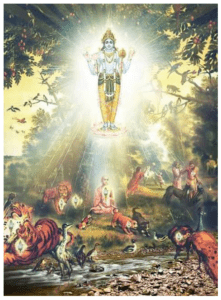 Once, while immersed in samādhi, Acyuta Dās[1] was blessed with the divine vision of the Supreme Absolute, the Niraṅkara Nārāyaṇa and seizing this opportunity he wished to be graced with the precious knowledge of Nāma Tatva. Upon which, the Supreme Lord Nārāyaṇa Jagannāth imparted the philosophy of Nāma or names.
Once, while immersed in samādhi, Acyuta Dās[1] was blessed with the divine vision of the Supreme Absolute, the Niraṅkara Nārāyaṇa and seizing this opportunity he wished to be graced with the precious knowledge of Nāma Tatva. Upon which, the Supreme Lord Nārāyaṇa Jagannāth imparted the philosophy of Nāma or names.
The Emergence of Aum
In the beginning there was the great Void or Śunya (zero). The five primordial elements or the pañca bhūtas, the 14 lokas or the caturdaśa bhuvanas, the Universe, dyu and Space, water and air, sound and light nothing existed. There was neither death nor life, no day nor night, neither beginning nor end. There existed only the one Brahmaṇ, immersed in the mire of dark ignorance and undivided from its Māyā, formless and without any attributes or qualities. Then from this Śunya, the Parameśvara desired to create, and upon this desire, creation took place and the Universe unfolded.[2] The Supreme Being appeared with qualities and attributes; its creative energy latent within was stirred and activated, and manifested itself, to eventually give birth to this splendorous world.
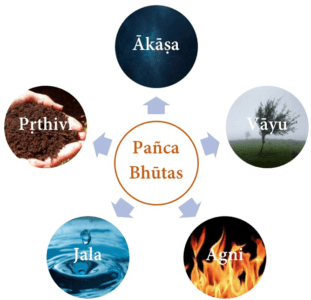 Niraṅkara Nārāyaṇa commenced his teaching by advising Acyuta not to run after that which is gross (sthula) in the form of the pañca bhūta (the five elements) and instead focus the mind on the subtle (sukṣma) in the form of the pañca tanmātrā. These five tatvas and bhūtas are the primary essentials among the 24 tatvas that created this material world[3]. This physical world was created by ichā or desire, which was expressed in the bindu (dot), which is the principle creator. The desire to create lies latent in the bindu and as it develops, moha[4] is generated, particularly for the created object. The energy that is required to liberate the latent creative potency dormant in the bindu and manifest itself into the created world is śakti, the divine feminine principle. It is an impulse inherent within the Śunya, which activates the process of creation (A), sustains (U) the universe and then subsequently destroys (M) it. Motivated by this desire or ichā, the bindu fell through the sky as a smoky ashy hue (dhumra varṇa), and the guṇas (essential attributes/qualities of creation in the form of satva, rajas and tāmas) were activated.
Niraṅkara Nārāyaṇa commenced his teaching by advising Acyuta not to run after that which is gross (sthula) in the form of the pañca bhūta (the five elements) and instead focus the mind on the subtle (sukṣma) in the form of the pañca tanmātrā. These five tatvas and bhūtas are the primary essentials among the 24 tatvas that created this material world[3]. This physical world was created by ichā or desire, which was expressed in the bindu (dot), which is the principle creator. The desire to create lies latent in the bindu and as it develops, moha[4] is generated, particularly for the created object. The energy that is required to liberate the latent creative potency dormant in the bindu and manifest itself into the created world is śakti, the divine feminine principle. It is an impulse inherent within the Śunya, which activates the process of creation (A), sustains (U) the universe and then subsequently destroys (M) it. Motivated by this desire or ichā, the bindu fell through the sky as a smoky ashy hue (dhumra varṇa), and the guṇas (essential attributes/qualities of creation in the form of satva, rajas and tāmas) were activated.
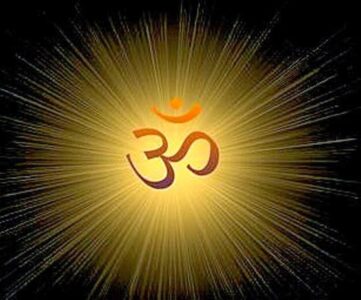 Astrologically, this can be translated as a Jupiter-Ketu combination, Ketu representing smoke and Jupiter the all binding ether element or ākāśa tatva and together it created life or can be denoted as creation itself.
Astrologically, this can be translated as a Jupiter-Ketu combination, Ketu representing smoke and Jupiter the all binding ether element or ākāśa tatva and together it created life or can be denoted as creation itself.
As ichā mobilized the guṇas and changed them, the bindu changed colour from ash to blue and then to red. These three colours are the three śaktis, Bhū, Śrī and Nīla and the three guṇas satva, rajas and tāmas. These three śaktis came together and ichā or desire was manifested as Aum.
Table 1

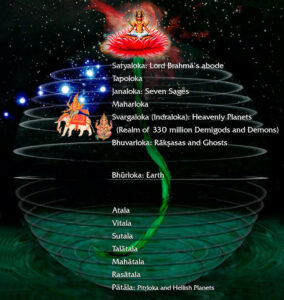 In reality, the śaktis are undifferentiated from the Aum, for it is not only the primordial energy but also the material matrix itself in which the manifest world is grounded and, in that sense, śakti is at once latent and manifest, both static and kinetic. The bindu’s manifestation as the Aum is the first manifestation of the material world and this is Brahma.
In reality, the śaktis are undifferentiated from the Aum, for it is not only the primordial energy but also the material matrix itself in which the manifest world is grounded and, in that sense, śakti is at once latent and manifest, both static and kinetic. The bindu’s manifestation as the Aum is the first manifestation of the material world and this is Brahma.
From Aum the 14 types of knowledge emerged, beginning with the four Vedas and from this knowledge the caturdaśa bhuvanas (14 realms/worlds) were created, of which seven are lokas, the heavenly realms while the other seven are the talas or the underworlds.
The seven lokas are ruled by Jupiter and the seven talas by Venus, the two gurus of the zodiac.
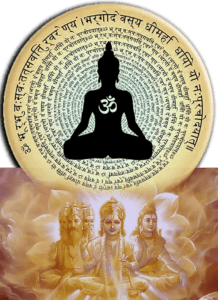 In this manner, from the great void of nothingness or Śunya, Aum emerged and eventually it merges back into the nothing and this flow of emergence and dissolution is the līlā (play) of the Paramātmā and is the path of mokṣa. “Meditate upon this Aum”, Acyuta writes, “as this is Nirākāra Brahmā.” Aum is the first name of God and the first stage of manifestation. The only truth that manifests is this name of God and that is Aum. The name is the only truth as nothing else will remain and nothing else is real. All siddhas and yogis meditate upon this Aum, which is the only truth. It is only Aum which is replete with satva guṇa and binds the universe. The strength of the name enabled the sādhus to comprehend the mysteries of the entire creation and to reach vaikunṭha or Viṣṇu loka. From this one name Aum, the other names of God emerged and the first to appear were Brahmā, Viṣṇu and Maheśvara.
In this manner, from the great void of nothingness or Śunya, Aum emerged and eventually it merges back into the nothing and this flow of emergence and dissolution is the līlā (play) of the Paramātmā and is the path of mokṣa. “Meditate upon this Aum”, Acyuta writes, “as this is Nirākāra Brahmā.” Aum is the first name of God and the first stage of manifestation. The only truth that manifests is this name of God and that is Aum. The name is the only truth as nothing else will remain and nothing else is real. All siddhas and yogis meditate upon this Aum, which is the only truth. It is only Aum which is replete with satva guṇa and binds the universe. The strength of the name enabled the sādhus to comprehend the mysteries of the entire creation and to reach vaikunṭha or Viṣṇu loka. From this one name Aum, the other names of God emerged and the first to appear were Brahmā, Viṣṇu and Maheśvara.
The Emergence of Svaras or the Alphabet
The first manifestation of creation was in the subtle plane, at the level of the tanmātrās, and this was śabda or sound as Aum, which is ruled by Jupiter.
Table 2

Aum is the Paramātmā or the Supreme Being as Śabda or Nāda Brahmaṇ and from Aum, the other sounds or svaras materialized. The first svaras to appear were the 16 vowels:
Table 3: The 16 vowels
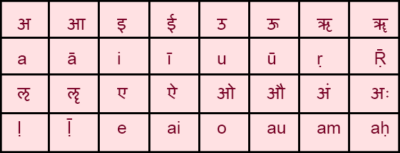

These 16 vowels were formed as a 16 petalled lotus in the viśuddha or throat cakra by Śiva, in the centre of which rests the Amṛta Kalaśa or the Pot of Immortal Nectar. Śiva as Mṛtyunjaya, (He who has conquered death) manifests Himself as Amṛteśvarī, or the Goddess of Immortality and at sunrise each day, a drop of nectar falls from the Pot to the base of the mouth, rejuvenating the jivātmā. It is as if one dies each night when one goes to sleep and is reborn next morning by the nectar that drips down the throat at dawn from the Amṛta Kalaśa. Lord Mṛtyunjaya gives new life each morning after the daily death of nightly sleep. Each day thus is like a fresh cycle of creation and destruction, with the creative process commencing with the materialization of sound. It is the macrocosmic drama being played out at a microcosmic level.
Sound at the microcosmic level of the jivātmā appears as svara in the viśuddha cakra in the form of the 16 vowels which are divided in two groups of eight vowels each, of which the first group of vowels is short, and the second group of vowels is long.
Short: a, i, u, ṛ, ḷ, e, o, am
Long: ā, ī, ū, ṝ, ḹ, ai, au, aḥ
There are five primary vowels based on the pañca tatvas or the five primordial elements, which are known as the pañca svaras. The specific elemental nature of each vowel, assigns a particular characteristic to these svaras, namely form, name, intelligence, conscience and shelter. These svaras are essential, containing the pañca prāṇas (five types of vital air), and representing the pañca ātmās (five types of ātmā).
The first vowel ‘a’ is known as the Brahmākṣara, as it initiates manifestation of the physical world and is therefore associated with form, breath and knowledge, the very buildings blocks of the living being. The second vowel, ‘i’ is associated with jala tatva which represents desire. The type of prāṇa associated with it is Apāna vāyu; that vital air which moves downwards and is expelled through the excretory organ. It is related to Nāma or name, for as desire drives one towards ignorance, the sense of the self grows stronger, and the ego emerges. With that, the need for a name or a specific identification for the jivātmā arises. Hence the bīja for this svara is klīm or Kāma bīja. The klīm bīja is generally used for worshipping Kṛṣṇa. Kāma means desire and one of the reasons klīm is used for worshipping Kṛṣṇa is because Kṛṣṇa is the ultimate desire of a person, the highest yearning that one harbors during a lifetime. Desire for material and physical satiation is tāmasik desire. The only true desire is to yearn for Kṛṣṇa and this is expressed through the Kāma bīja, klīm.
Table 4: Acyuta’s Pañcātmikā Tatva

Bījākṣara
The 16 svaras provide the basis for bījākṣaras or seed syllables which are prefixed before mantras. They reside in the viśuddha cakra in the form of a 16 petalled lotus. By meditating on each petal, one is blessed with the powers of speech. Each vowel is like a bīja or seed which when attached to a consonant, produces an akṣara or syllable. The consonant is the body; so, when a seed attaches itself to a body, an akṣara comes into existence. For example, consonants ‘r’ and ‘l’ when attached to the vowel ‘a’ produces the bījas ra and la. Ra or ram bīja is ruled by Agni tatva and portrays repulsion. La or lam bīja is ruled by jala tatva and signifies attraction. Ram as Agni moves the energy of the worshipper upwards, towards God. It is the fire that burns sin and this śakti or energy that must evolve within is best described by Kāli, as she is the only one who can devour the sins burning within the deepest recesses of one’s being. Hence, she is worshipped with the krīm bīja, ra or Agni added to the consonant ‘k’ and the vowel ‘i’. La or lam as jala tatva brings God down to the worshipper and is responsible for blossoming divine love or bhakti within the heart, and hence Kṛṣṇa, the Eternal Lover, is worshipped with the klīm bīja. Here la is added to the same consonant ‘k’, and this enables the devotee to move towards the path of divine love or bhakti mārga.

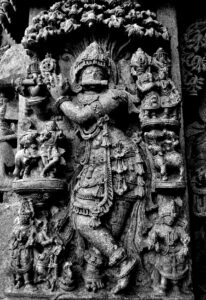
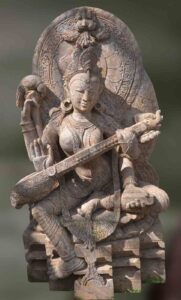
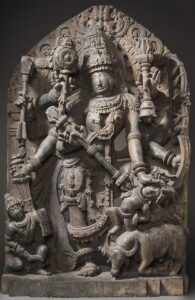
Similarly, there are multifarious bījas, both singular and compound[5], which are used in Mantra Śāstra[6] especially in the Tantra paramparās[7]. Table 5 shows some of the common uses of the vowels when converted to bījas and the kind of knowledge it leads to. For example, aiṁ, otherwise known as the vāg bīja is for worshipping Sarasvatī the Goddess of speech and learning. Huṁ, which is known as the kurca bīja, is for suppressing evils. The bīja duṁ is used for worshiping Goddess Durgā, as she removes and destroys all danger. Rāṁ and Vaṁ are the bījas for Agni and Jala respectively and they are associated with the Brahmākṣara, which stands for creation.
Table 5

Nāmākṣara: The Seed of the Name
Similarly, names as used in the physical world have bījākṣaras. The first letter of a name is the haṁsaḥ or the soul and this is not accidental. The syllable with which the name starts is the consonant, which forms the bījākṣara in conjunction with the vowel ‘a’ or ‘am’, and this is known as the nāmākṣara. The nāmākṣara is the bīja. From the Nāmākṣara or bīja the name comes into existence for it is the bīja which creates the name and not vice versa. The nāmākṣara cannot come into being by itself only with the consonant as that would constitute merely a body. It requires the presence of the ātmā or soul, which is known as the haṁsaḥ, to create a bījākṣara. Here, the vowel is the haṁsaḥ or the soul. When the soul or the haṁsaḥ enters the body, a life or jivātmā is born. Hence the conjoining of a vowel with a consonant creates a letter or akṣara. From this akṣara our personal bījākṣaras are obtained, which is the nāmākṣara. Examples:
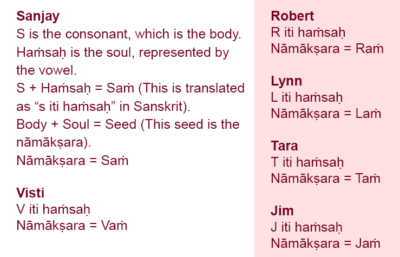

Nāmākṣara in the Rāsī Chart
A name made of a single letter is a bīja, as discussed above, but names are also composed of 2, 3 or 4 letters. Those having more than 4 letters or akṣaras are to be reduced to 2, 3 or 4 akṣaras by removing multiples of 3. If a name consists of 5 letters, then remove 3, and the number that is obtained is 2. Names framed with 2, 3 and 4 letters represent the cara, dvisvabhāva and sthira rāśīs and characteristics of these rāśī will imprint itself on the native.
The nāmākṣara belongs to a particular nakṣatra, the formula for which is given below:
Table 6: Nāma Nakṣatra[8]
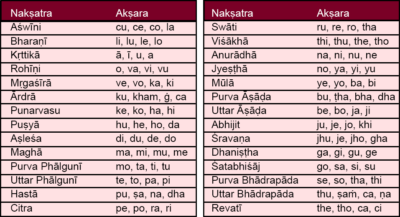
Determine the rāsī from the nāma nakṣatra and then examine this rāsī in the natal chart. If the nāma rāsī is corresponds to the lagna or lagna kendra, then the amount of satya or truth in the person and his life would be high. If it does not correspond to the lagna, then see whether it associates with the Moon and its kendras. If the nāma rāsī does not correspond with either lagna or the Candra Lagna then the suffering in the life of the person will be high, as the degree of satya would be minimal. Satya or truth is strong in the lagna and candra kendras, stable in the paṇapharas and is in a declining mode in the apoklimas. The following is an example of three brothers all of whom have their nāma rāśi in Aquarius but have grown to lead completely different and separate lives.
Chart 1
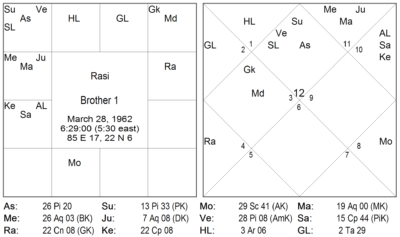
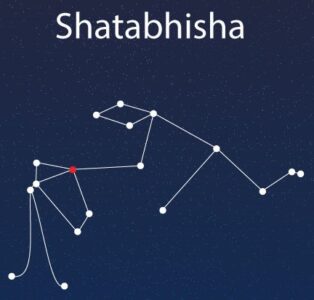
This is the chart of the eldest brother. The first letter is ‘Su’, which corresponds with Śatabhiśāj nakṣatra and falls in Aquarius, which becomes his nāma rāsī. It is placed in Candra kendra in the 12th house aspected by its lord, Rāhu and conjunct the 7th and 9th lords, Mercury, and Mars. The nāma rāsī also happens to be his Pāka Lagna, with the presence of Lagna Lord Jupiter, making the association with both lagna and candra lagna very strong. At a very young age, soon after finishing his primary education, he left India for the United States, where he settled and attained wealth and prosperity. The 3rd (short distance), 7th (travel in general) 9th (long distance) and 12th (settlement in a foreign country) signify travel. The nāma rāśī is the 12th house associated with these travel house lords. The 7th lord from the nāma rāśī is Sun placed in the lagna, where there is a strong Mālavya Māhapuruṣa Yoga. Once he settled abroad, he married a foreigner (UL lord Jupiter is in the nāma rāsī), attained wealth, and the Māhapuruṣa Yoga was instigated. Observe the strong influence of Rāhu, as nāma rāśī lord and aspecting the rāśī as Rāhu signifies strong foreign influence.
Chart 2
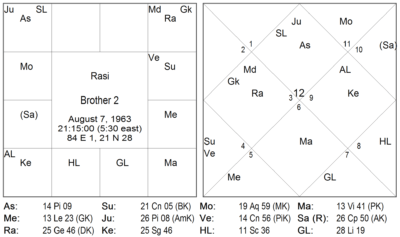

This is the chart of the second or middle brother. The first letter is ‘Sa’, placed in Aquarius. The Moon is placed in the nāma rāśī, assuring fame. Mercury is in the 7th from it, forming a beautiful Śaradā Yoga, giving him the skills of writing and learning, hence the fame is because of his writing and scholarship. The 7th lord from the nāma rāśī Sun is conjunct the 8th lord and aspecting the nāma rāśī, showing that the fame is for occult studies (8th lord), specifically jyotiṣa (Sun). The aspect of Rāhu conjoining Śatru pada (A6) indicates trouble from rivals and enemies, and once again the placement of nāma rāśī in the 12th house shows that the fame assured by the Moon will be achieved in foreign countries.
Chart 3
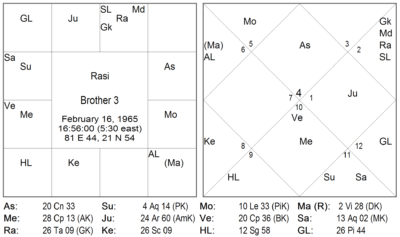
This chart is of the youngest brother. The first letter is ‘Su’ and the nāma rāśī is in Aquarius once again. It is the 8th house and is in candra kendra, showing the attempt to adhere to the path of satya. The placement of Sun and Saturn in the sign of Rāhu, in the nāma rāśī, however explains the tragedy of this brother. Unable to break the umbilical cord, he still lives with his father living out a stereotypical Sun-Saturn relationship with him, which has prevented him from moving on in life and from making a mark for himself. It has seriously affected his professional and marital lives shown by the UL, A10 on the nāma rāśī axis.
Chart 4: Anonymous 1
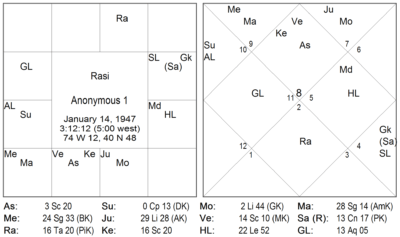

The nāmākṣara is ‘jo’ which is in the 3rd pada of Abhijit nakṣatra and this is mapped into the sign of Capricorn which is her nāma rāśi. The nāma rāśi is in a dusthāna from the lagna in the 3rd house with the Sun in it and aspected by Saturn in the 7th from it, indicating hardships, especially those related to resources, and a lot of effort for overcoming this situation. From the Moon, the nāma rāśi is in a kendra (4th) and it is a Moon conjunct Jupiter. Indeed, during Jupiter daśa, the native was a pediatric surgeon of repute (signified by Jupiter-Moon and nāma rāśi in the 4th house of cure and healing from Candra Lagna). Once Saturn daśa commenced, the native lost everything she had and after much hardship and effort (nāma rāśi in the 3rd house of parākrama), she restarted her life as an astrologer. In the process she stopped using her last name and now uses only her first and middle names. As a dual sign is rising, she has two āruḍas: one from Mars and the other from Ketu. The Mars āruḍa is Capricorn while the Ketu āruḍa is Aquarius. So she changed from the Capricorn āruḍa of Mars (surgeon) to the Aquarius āruḍa of Ketu (astrology and spirituality).
Chart 5: Name Change
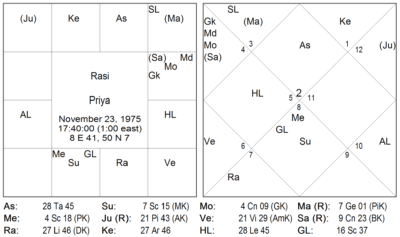

This is a fine example of name change from Filip to Priya, which completely altered the native’s life. ‘Pi’ (in lieu of F) falls in the last pada of Uttara Phālgunī nakṣatra and is mapped into the sign Virgo, which is his nāma rāśi. Virgo has debilitated Lagna Lord Venus in the 5th house of love and aspected by a retrograde Mars from Gemini. He was caught in the world of drugs and everything unappetizing regarding his relations with the opposite sex that a debilitated Venus aspected by Mars indicates. Venus gets nīcabhanga by Mercury which signifies change in and of name. This change in name was brought about by Jupiter in Pisces in the 7th from the nāma rāśi and aspecting it. So this change did not come about easily, but when it did come, it was brought about by a guru, who initiated him under memorable and unusual circumstance and changed his name to Priya. Slowly he veered towards a spiritual path, which included learning jyotiṣa and starting and owning an electronic discussion group on jyotiṣa. Gradually (retrograde Jupiter) he made a move to shift out of his drug circle and engage in a more meaningful life, which included receiving another Krishna mantra (Mercury) from another paramparā.
The Kaṭapayādi Method of Nāma Rāsī
A second method of deriving a nāma rāśī is through the Kaṭapayādi method. The Kaṭapayādi system is a part of traditional techniques along with various other cakras for determining suitability of names and mantras. The method for calculating the nāma rāśī from the Kaṭapayādi varga is given below.
Calculating the Kaṭapayādi Varga[9]
- Each of the Sanskrit vowels have a zero value (Table-1) and,
- Each of the consonants Ka, Ta, Pa & Ya has a numerical value of one, hence the name Kaṭapayādi Varga.
- The consonants following these have a sequentially higher numerical value (Table-2).
Table 7: Kaṭapayādi Varga – Vowels
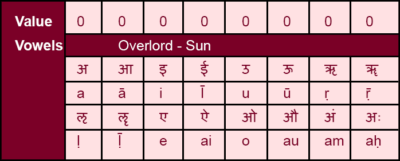
Table 8: Kaṭapayādi Varga – Consonants
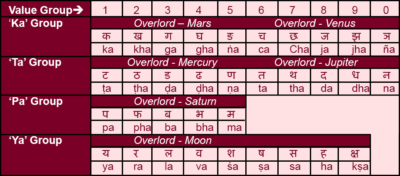
- Step 1: Write the word of the stanza in Devanāgarī script and remove the “mātrā’s” and incomplete/half letters.
- Step 2: The numerical value of the remaining letters should be written sequentially.
- Step 3: The number so obtained should be reversed.
- Step 4: Divide this reversed number by 12.
- Step 5: The remainder gives the sign/house referred to in the stanza.
- Step 6: No consonant has a numerical value above 9. For those which show 10, take the value to be 0.
- Step 7: When there is no remainder take 12.
The Kaṭapayādi Nāma Rāśī
The numerical value arrived at through the Kaṭapayādi varga is the nāma rāśī. For example, if the numerical value arrived at is 3, then see the 3rd bhāva from the natural zodiac or the Kālapuruṣa. Take the sign indicated by the bhāva, in this case, Gemini, and examine Gemini in the rāśī chart. This will show what the native will give to the world. Gemini shows writing, communications, prowess etc. and these are the factors that one will give to the world. Then check the 3rd house in the rāśī chart and this will show what the native (jātaka) will receive from the world.
Chart 6: Wolfgang Amadeus Mozart
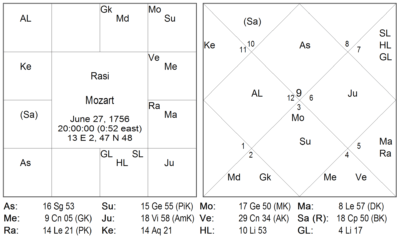
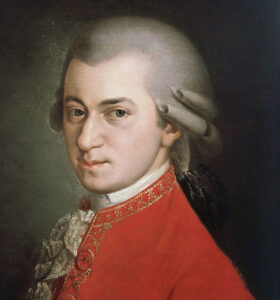
The world knew him as Mozart, and after dropping the vowels we get the consonants M, Z, R and T. The following numerical values are assigned to these letters following the Kaṭapayādi table:
- M: 5
- Z: 7
- R: 2
- T: 1
The number arrived at is 5721. Reversed it becomes 1275. This is divided by 12 and the remainder attained is 3. The third house in the natural zodiac is occupied by the sign Gemini. Gemini in Mozart’s chart has the Sun and Moon aspected by Jupiter. What he gave to the world, as one of its greatest composers, is the most unbelievable music and melody for symphonies, operas, concertos, for the piano, the violin, the flute. The Sun rules rhythm and musical instruments and the Moon rules melody, and it is a combination of the two that he offered to the world which has etched his name forever at the pinnacle of fame; fame guaranteed by the Moon with the aspect of Jupiter, forming a Gajakeśarī Yoga.
He received from the world Aquarius occupied by Ketu and aspected by Mercury and Venus. Aquarius has UL and the 7th from it has Mars and Rāhu with the A7. Mozart was slandered and ridiculed in his lifetime for his promiscuousness and obnoxious, vulgar behaviour including an unconventional sexual life. Aspect of 6th lord Venus conjunct Mercury shows the unbridled jealousy of court musician Salieri, who haunted Mozart throughout his life denying him official accolade and the favour of the court. Mozart died young; in poverty and ridicule but recognized as a genius by many at the time of his death.
Chart 7: Śrī Rāmacandra of Ayodhyā

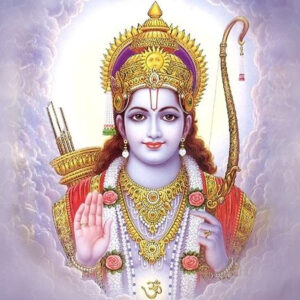
Rāma breaks down into two consonants: R and M. The number derived is 25, which when reversed is 52. When divided by 12 the remainder is 2. The 2nd house from Aries is Taurus, and in Rāma’s chart it is occupied by Mercury. Harihara says that Mercury in the 3rd Drekkana of fixed signs depicts Viṣṇu, and Śrī Rāma is one of the highest avatars to have graced this mortal plane; in fact, he was worshipped as Nārāyaṇa himself. Taurus is aspected by an exalted Mars and Saturn, and he gave to the world his unmatched valour and battling prowess, by which he purged the world of evil and darkness by commanding a powerful army across the oceans. Taurus is also aspected by the lagna Cancer with Jupiter and Moon in it forming a perfect Gajakeśarī Yoga, portraying in its highest form, divinity and unmatched fame and glory. Jupiter and Moon in lagna shows that beyond everything else, Rāma gave to the world his name, so pure and holy, that by the mere chant of that name, Rāma, the sins of many births vanquish, and all evil disappears. This is Nāma Tatva at its epitome, where the name itself as deity and mantra, as divinity itself, has the power and energy to exist by itself. The name is everything, the only reality and truth. Like Om. The repetitious chanting of God’s name therefore is advocated as one of the highest forms worships in all religions across the world, and this is known as japa.
Rāma received from the world the 2nd house, which is Leo aspected by three exalted planets Saturn, Mars and Sun. Saturn in the 4th gave him sorrow from family specially mother. Mars in the 7th got his wife kidnapped and for which he saw war and violence. The Sun exalted in the 10th gave him a huge kingdom and loyal and devoted subjects and made him exemplary as a king.
Chart 8: Albert Einstein
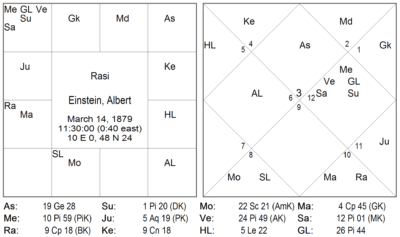
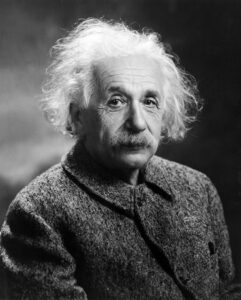
After removing the vowels and the half letter ‘S’, the consonants remaining are N, T, N which have the values of 0, 1 and 0. Reversed it remains the same and when divided by 12, the remainder is 10. The 10th house from Aries is Capricorn and Capricorn in Einstein’s chart has Mars and Rāhu. This signifies the bomb, explosions of an unimaginable magnitude and unpredictable consequences which was triggered suddenly and took the world by surprise (Ketu). The sign of Capricorn represents the dark and malefic energies of the 21st century. Mars exalted in it conjunct Rāhu shows energy of a stupendous nature and Vijaya Yoga, the combination for absolute victory. Capricorn is in the 5th from the Āruḍa Lagna, showing that this invention gave him power and position. This is what he gave to the world as far as his name is concerned. Although Einstein did not wish his inventions to be abused for this purpose, in the common mind, his name is associated with the manifestation of the nuclear energy.
He received from the world the 10th house, which in his chart has a concentration of four planets including an exalted Ātmā Kāraka, Venus forming a Mālavya Māhapuruṣa Yoga. He is indeed a great persona of his times, and his name blazes in the annals of history as one of the greatest scientists ever born. His focus was on karma (note the exchange between the 9th and 10th lords forming Dharmakarmādhipati Yoga) and he received from the world aplenty from his work and profession. His name is synonymous with his work.
Chart 9: Adolf Hitler


The consonants derived from the name Hitler is H, T, L, and R which gives the number 8132. Reversed the number is 2318, which when divided by the number 12 gives the remainder 10. The 10th house from Aries is Capricorn and this has the Ghāṭikā Lagna in it and aspected by Saturn in Cancer in the 7th from it. Ghāṭikā Lagna indicates power and position and Saturn in Cancer signifies rāja yoga of the highest order. As Saturn is involved in this yoga, the rise and sustenance of this yoga is by the methods of Saturn, indicating dictatorial tendencies and abuse of power. This is what Hitler gives to the world. Interestingly, the 10th house is this very Saturn in cancer, which is also his Āruḍa Lagna. What he received from the world was the very same thing and his āruḍa rose on the basis of this use and abuse of power which made him one of the most powerful and hated dictators of the world. This Saturn is also aspected by Rāhu and Mars giving a very clear idea of the nature of power used. The name Hitler is associated with this saturnine power of a great magnitude which made him the dictator of one of the greatest nations of the world and made his name indelible in history for propagating methods of mass racial exterminations of inconceivable cruelty and inhumanity.

* This paper is based on the writings of Śrī Acyuta Dās in his Chayaliśa Paṭala and from parampara knowledge as learnt in Sri Jagannath Center from my jyotiṣa guru, Sanjay Rath. Chayaliśa Paṭala is written in Oriya and is not yet available in English. This has been translated orally and taught by Sanjay Rath to some of his students at Sri Jagannath Center.
[1] Acyuta Dās was one of the pañca sakhās or the five companions of Śrī Caitanya. A great saint, he approached the spiritual through the path of jyotiṣa and is the source of lineage of the SJC paramparā.
[2] ṛg Veda, 10/129, Nāsadīyasukta
[3] This is elaborated as Sāṁkhya philosophy key works of which include Sāṁkhya Kārikā, Tatva Kaumudi, and Pañcadaśī etc.
[4] Moha is illusion, a delusion of the mind created by bewilderment and awe, leading to error and ignorance. Intrinsically, the first great mental delusion is ahaṁkāra which leads to ignorance.
[5] Kuṭa Bījas
[6] Science of Mantras
[7] Mantras are of two kinds, Vedic and Tantrik. Tantrik mantras practice the use of a variety of bījas.
[8] Study the Hoḍā Cakra from any standard jyotiṣa book for details and explanations.
[9] The calculation method has been quoted from Jaimini Mahāṛṣi’s Upadeśa Sutra, translated by Sanjay Rath and published by Sagar Publications, New Delhi, India.

0 comments